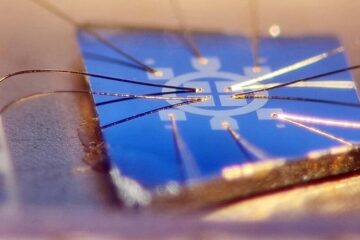CU physicists use ultra-fast lasers to open doors to new technologies unheard of just years ago

Recent breakthroughs by their team at JILA, a joint institute of CU-Boulder and the National Institute of Standards and Technology, have paved the way on how to build a tabletop X-ray laser that could be used for super high-resolution imaging, while also giving scientists a new way to peer into a single cell and gain a better understanding of the nanoworld.
Both of these feats could lead to major breakthroughs in many fields including medicine, biology and nanotechnology development.
“Our goal is to create a laser beam that contains a broad range of X-ray wavelengths all at once that can be focused both in time and space,” Murnane said. “If we have this source of coherent light that spans a huge region of the electromagnetic spectrum, we would be able to make the highest resolution light-based tabletop microscope in existence that could capture images in 3-D and tell us exactly what we are looking at. We're very close.”
Murnane and Kapteyn presented highlights of their research today at the American Association for the Advancement of Science, or AAAS, annual meeting in San Diego, during a panel discussion about the history and future of laser technology titled “Next Generation of Extreme Optical Tools and Applications.”
Most of today's X-ray lasers require so much power that they rely on fusion laser facilities the size of football stadiums or larger, making their use impractical. Murnane and Kapteyn generate coherent laser-like X-ray beams by using an intense femtosecond laser and combining hundreds or thousands of visible photons together. And the key is they are doing it with a desktop-size system.
They can already generate laser-like X-ray beams in the soft X-ray region and believe they have discovered how to extend the process all the way into the hard X-ray region of the electromagnetic spectrum.
“If we can do this, it could lead to all kinds of possibilities,” Kapteyn said. “It might make it possible to improve X-ray imaging resolution at your doctor's office by a thousand times. The X-rays we get in the hospital now are limited. For example, they can't detect really small cancers because the X-ray source in your doctor's office is more like a light bulb, not a laser. If you had a bright, focused laser-like X-ray beam, you could image with far higher resolution.”
Their method can be thought of as a coherent version of the X-ray tube, according to Murnane. In an X-ray tube, an electron is boiled off a filament, then it is accelerated in an electric field before hitting a solid target, where the kinetic energy of the electron is converted into incoherent X-rays. These incoherent X-rays are like the incoherent light from a light bulb or flashlight — they aren't very focused.
In the tabletop setup, instead of boiling an electron from a filament, they pluck part of the quantum wave function of an electron from an atom using a very intense laser pulse. The electron is then accelerated and slammed back into the ion, releasing its energy as an X-ray photon. Since the laser field controls the motion of the electron, the X-rays emitted can retain the coherence properties of a laser, Murnane said.
Being able to build a tabletop X-ray laser is just the beginning, said Kapteyn.
“An analogy that is pretty close to what is going on in this field is the MRI, which started as just a fundamental investigation,” said Kapteyn. “People then started using it for microscopy, and then it progressed into a medical diagnostic technique.”
Murnane and Kapteyn were recently recognized with the American Physical Society's Arthur L. Schawlow Prize in Laser Science for “pioneering work in the area of ultra-fast laser science, including development of ultra-fast optical and coherent soft X-ray sources.” The prize, which was endowed by NEC Corporation in 1991, recognizes “outstanding contributions to basic research which uses lasers to advance our knowledge of the fundamental physical properties of materials and their interaction with light.” Nobel laureates and CU-Boulder physics Professors Carl E. Wieman (1999) and John L. Hall (1993) also have won the award.
For more information about Murnane and Kapteyn's work visit their research group page at http://jila.colorado.edu/kmgroup/home.html.
Media Contact
More Information:
http://www.colorado.eduAll latest news from the category: Physics and Astronomy
This area deals with the fundamental laws and building blocks of nature and how they interact, the properties and the behavior of matter, and research into space and time and their structures.
innovations-report provides in-depth reports and articles on subjects such as astrophysics, laser technologies, nuclear, quantum, particle and solid-state physics, nanotechnologies, planetary research and findings (Mars, Venus) and developments related to the Hubble Telescope.
Newest articles

Boron deficiency: oilseed rape reacts as with infection and pest infestation
Genetic mechanisms uncovered… Boron deficiency has a devastating effect on oilseed rape and related plants. However, little is known about the underlying genetic mechanisms. A study shows that the response…

Quantum Precision: A New Kind of Resistor
Researchers at the University of Würzburg have developed a method that can improve the performance of quantum resistance standards. It´s based on a quantum phenomenon called Quantum Anomalous Hall effect….

Security vulnerability in browser interface
… allows computer access via graphics card. Researchers at Graz University of Technology were successful with three different side-channel attacks on graphics cards via the WebGPU browser interface. The attacks…





















